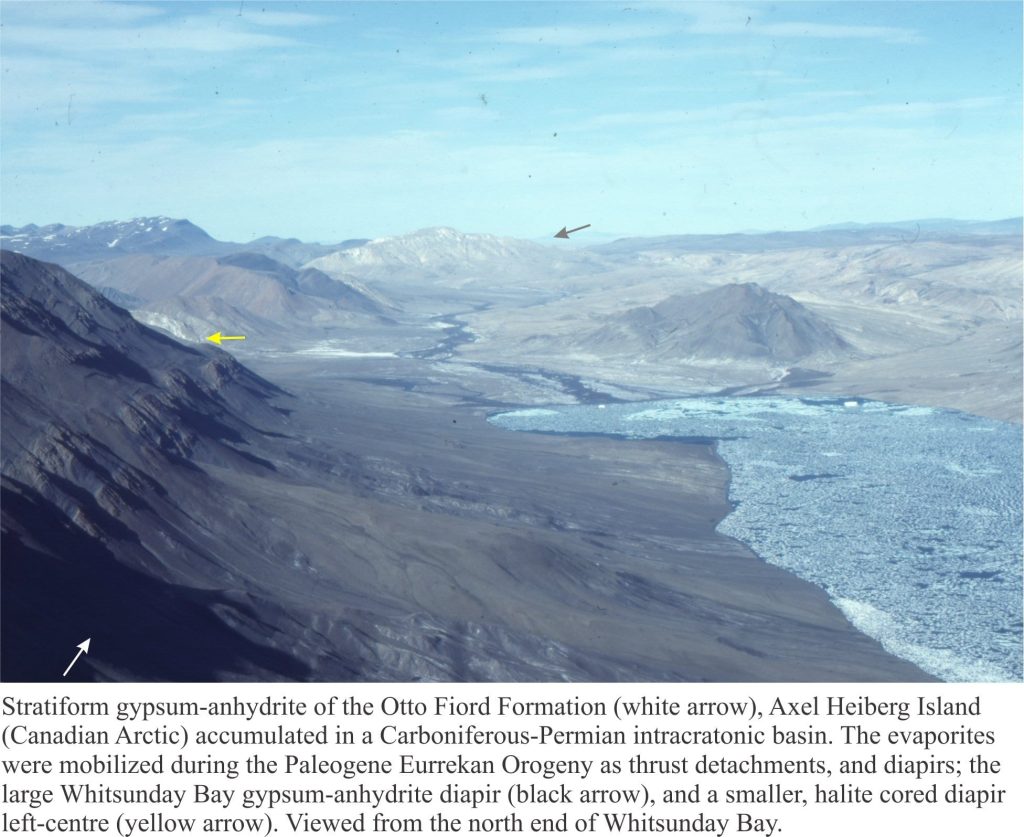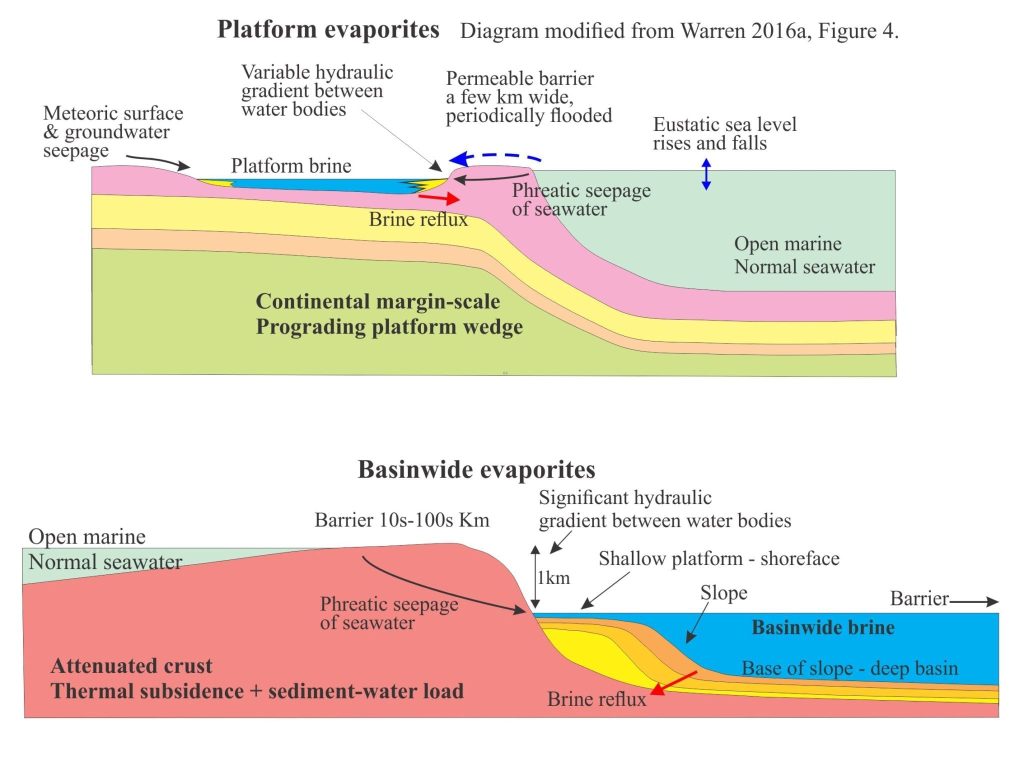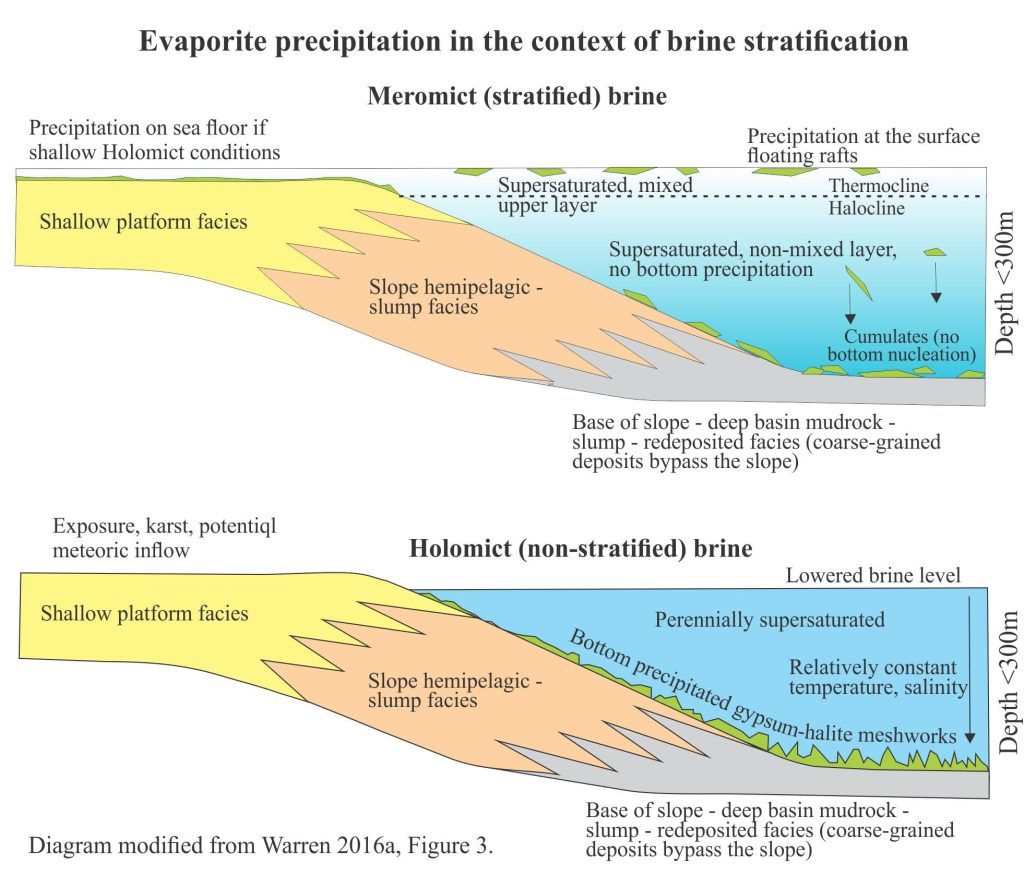Deposition of marine platform and basin-wide evaporites
This is part of the How To…series on evaporites
The number and variety of modern saline lake analogues is a convenience that has produced workable geological models. Saline lakes accumulate in smallish basins having variable areal extent and depth; brine chemistry is also variable and strongly dependent on bedrock and soil chemistry. In contrast, the thickness of ancient marine evaporites is commonly measured in 100s of metres, areal extents in 10s to 100s of 1000s of square kilometers, and brine chemistry dominated by seawater. There are no good modern analogues for these massive, ancient marine evaporites (good summaries in the references below). Two of the largest evaporite successions include the Jurassic of Gulf of Mexico (2.4 million km3 volume) and the Messinian (Late Miocene, Mediterranean – 2.2 million km3 volume). One of the most intensely studied evaporite units that extends across northern Europe and North Sea is the Permian Zechstein, that in places has cumulative salt thicknesses of 600m and more.
In developing models for marine evaporite formation, earth scientists have had to grapple with the physical and geochemical mechanisms that account for the great thicknesses of virtually pure halite and gypsum. The models need to account for:
1. An uninterrupted supply of solute in very large quantities. The only viable source is seawater.
2. A perennial negative water balance. Here, egress of water by evaporation and seepage reflux must exceed inflowing dilute water, whether by marine incursions, subsurface seepage, or meteoric runoff.
3. In most basins, the loss of water by evaporation greatly exceeds all other mechanisms of water removal. Climate is therefore a critical component of the models.
Excellent summaries of evaporite basin models and their geochemical conditions are provided by Warren (2016a, 2016b) and Bąbel and Schreiber (2014). Frequently invoked models are shown in the diagrams below. The first diagram shows two end-member models of platform and basin-wide evaporites. The second set of diagrams show evaporite precipitation in terms of brine stratification. Each model requires a degree of basin isolation – a physical barrier that restricts the developing brine from dilution by normal, open-ocean seawater.
As is the case with all scientific models, those presented here speak in generalities. There are always exceptions.
The platform model deposits evaporites a few 10s of metres thick, that interfinger with shallow water siliciclastic and carbonate facies and their associated fauna and flora, including shoreface and sabkha facies. The shallow conditions and limited sediment accommodation space means that evaporitic drawdown produces brine levels only marginally below sea level. Therefore, there is minimal hydraulic potential for gravity-driven seepage of new seawater through a permeable seaward barrier. The hydraulic potential for seepage will also vary as eustatic sea level cycles through highs and lows (probably 4th order and higher cycles); the potential for seepage will increase during sea level lowstand, and decrease during highstands. Breaching of the platform barrier during high sea levels may temporarily dilute the brines and reduce mineral saturation. A sea level rise that breaches the barrier will also produce carbonate facies interbedded with the evaporites.
The basin-wide model has its foundation on subsiding, attenuated crust. The accommodation space incorporated in this model is sufficient to explain many ancient, thick evaporites (500 m and more), in intracratonic basins or basins formed during the early stages of continental rifting. Water-brine depths may be an order of magnitude greater those across platforms. Therefore, associated sedimentary facies will range from high energy shallow marine clastics, carbonates, and reworked evaporites, to slope and deep-basin mudrocks and redeposited coarse-grained sediments. There are no modern analogues for this type of basin; according to Warren (2016a) the Late Miocene (Messinian) Mediterranean drawdown is the latest example of basin-wide evaporites. Thick basin-wide deposits of gypsum and halite commonly act as detachments in thrust belts, and as halokinetic structures because of buoyancy contrasts with the surrounding strata.
Hydrological conditions in the basin-wide model are fundamentally different to the those envisaged for the platform model. First, the basin can accommodate significant depths of seawater such that evaporitic drawdown results in brine levels 100s of metres below sea level. Second, the difference in fluid levels results in significant hydraulic potential for both meteoric groundwater flow and seawater replenishment into the basin, seawater being the most important for supply of solute (hydraulic potential, or hydraulic head is determined by the difference in elevation between sea level and the lowered brine level). Seepage of seawater also depends on the permeability of the seaward barrier. Dense brine may be lost from the basin by seepage reflux through deeper aquifers, or bottom flow through basin outlets.
The chemical, thermal, and density structure of the brine column determines the location and texture of precipitating evaporites. There are two end-member conditions:
- Stratified brine columns (meromict), and
- Non-stratified brine columns (holomict).
Note that whereas these are perennial conditions, it is possible for one to evolve to the other over the life of a basin.
Perennially stratified brines typically have a lower dense, warm layer overlain by a cooler less dense layer (the term meromict was originally coined to describe lakes having an unmixed bottom layer of water). The thermal boundary between the two layers is the thermocline; the corresponding salinity boundary is the halocline. The lower layer is warmer than the upper layer because it has a higher (thermodynamic) heat capacity. Mixing is confined to the upper layer, commonly by wind-driven currents. Mixing is minimal or non-existent in the lower brine, dissolved oxygen tends to be low and the biota is restricted to a few bacteria. Evaporite precipitation mostly occurs at the brine surface where mineral supersaturation is maintained by evaporation. Floating crystal rafts eventually sink to the basin floor; evaporite deposits formed in this way are called cumulates. Direct precipitation on the basin floor from the lower layer is restricted to shallow platform brines because supersaturation cannot be maintained at greater depths (there is little or no mixing of new dissolved salt).
In holomict brine columns, temperature and salinity are relatively constant throughout. Supersaturation is maintained by evaporation at the surface and subsequent mixing by wind-driven and/or bottom currents. One of the key indicators of holomict conditions is the presence of basin floor precipitates, even in the deepest parts of the basin. Precipitation forms crystal meshworks of halite and gypsum (the deposits are commonly monomineralic). Gypsum crystals formed in this way can reach extraordinary dimensions; iconic examples from the Messinian of Sicily and Poland have measured lengths of 3.5 m to 4.5 m! In the shallow parts of a basin, particularly above wave-base, evaporites can be reworked and interfinger with shallow carbonate sediments (early aragonite and high magnesium calcite cements predominate because of high salinities and elevated Mg/Ca ratios). Sedimentary structures commonly include crossbedding, erosional features, ooids and pisoliths, and various stromatolite buildups.
Related links
Mineralogy of evaporites: The rise of diapirs
Mineralogy of evaporites: salt tectonics
Mineralogy of evaporites: Saline lakes
Mineralogy of evaporites: Saline lake brines
Mineralogy of evaporites: Death Valley hydrology
Mineralogy of carbonates; basic geochemistry
Mineralogy of carbonates: sabkhas
References
K. Warren, 2016a. Evaporites. In W.M. White (Ed.) Encyclopedia of Geochemistry. Springer International, p. 1-8. Concise summary of marine evaporite basins.
J.K.Warren, 2016b. Evaporites: A compendium. Springer, 1854 p.
Bąbel and B.C. Schreiber, 2014. Geochemistry of evaporites and evolution of seawater. Treatise on Geochemistry. Elsevier, p. 483-560. Brief outline of basin models. Encyclopedic with extensive list of references




















